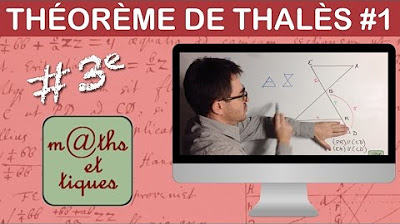O Teorema de Tales
Summary
TLDRIn this video, the host explains the importance of Thales' Theorem, which relates the proportionality between parallel lines and transversals. Developed by the ancient Greek philosopher and mathematician Thales of Miletus, the theorem is rooted in his observations of shadows cast by the Pyramid of Cheops. The video explores Thales' life and contributions to mathematics and philosophy, including the concept of similar triangles. Through an example involving parallel lines and transversals, viewers learn how to apply Thales' Theorem to solve proportional problems. The video concludes with a call to action for viewers to like, subscribe, and stay engaged for future content.
Takeaways
- 😀 Thales of Miletus was a Greek philosopher, astronomer, and mathematician who lived around 650 BCE.
- 😀 Thales is considered the 'father of geometry' and was the first mathematician and philosopher in history.
- 😀 The Theorem of Thales explains the proportional relationship between parallel lines and transversals.
- 😀 Thales discovered the theorem by observing the shadow of a pyramid and its relationship to the height of objects.
- 😀 The Theorem of Thales states that if two transversals intersect a set of parallel lines, the ratio of segments on one transversal is equal to the ratio of corresponding segments on the other transversal.
- 😀 The Theorem of Thales was derived from the observation of the shadows cast by a pyramid.
- 😀 Thales is known for his contributions to geometry and his innovative use of proportionality in mathematics.
- 😀 The theorem can be used to find unknown lengths by applying proportionality between the segments formed by parallel lines and transversals.
- 😀 The example used in the video shows how the Theorem of Thales can solve for unknown segment lengths, such as finding that x = 3 in a specific case.
- 😀 The video encourages viewers to engage with the content by liking, subscribing, and activating the notification bell for future videos.
Q & A
What is the main topic discussed in the video?
-The main topic of the video is Thales' Theorem, a mathematical principle that describes the proportional relationship between segments formed by parallel lines and transversals.
Who was Thales of Miletus and what was his contribution to mathematics?
-Thales of Miletus was a Greek philosopher, mathematician, and astronomer. He is credited with discovering Thales' Theorem, contributing to geometry, and is often regarded as the 'father of geometry.'
How did Thales of Miletus discover his theorem?
-Thales discovered the theorem by observing the shadow of the Pyramid of Cheops and realizing that the height of the pyramid could be calculated through a proportional relationship between the length of its shadow and the height of the object casting it.
What does Thales' Theorem state?
-Thales' Theorem states that if two transversals intersect a set of parallel lines, the ratios of the segments formed on one transversal are equal to the ratios of the corresponding segments on the other transversal.
What are the key elements involved in Thales' Theorem?
-The key elements in Thales' Theorem are two transversals intersecting a set of parallel lines, forming segments that are proportional to each other.
Can you provide an example to explain Thales' Theorem?
-Sure! Imagine three parallel lines (AB, CD, and EF) cut by two transversals (AE and BF). If AC is 'x,' CE is 4, BD is 12, and DF is 16, Thales' Theorem states that the ratio of x to 4 is the same as the ratio of 12 to 16. Solving the proportion gives x = 3.
What role do parallel lines and transversals play in Thales' Theorem?
-Parallel lines and transversals are essential for Thales' Theorem as they create proportional segments. The parallel lines create consistent ratios between the intersecting segments formed by the transversals.
Why is Thales referred to as the 'father of geometry'?
-Thales is referred to as the 'father of geometry' due to his foundational contributions to the development of geometry, particularly his work on similar triangles and proportionality, which later became fundamental concepts in the field.
How did Thales' Theorem contribute to the field of geometry?
-Thales' Theorem laid the groundwork for the study of proportionality in geometry, especially in the context of similar triangles, which are essential in many geometric proofs and calculations.
What can we learn from Thales' Theorem in modern mathematics?
-Thales' Theorem teaches us the importance of proportional reasoning and its application to geometric figures. It helps in understanding the relationships between angles, sides, and segments in various mathematical problems.
Outlines

このセクションは有料ユーザー限定です。 アクセスするには、アップグレードをお願いします。
今すぐアップグレードMindmap

このセクションは有料ユーザー限定です。 アクセスするには、アップグレードをお願いします。
今すぐアップグレードKeywords

このセクションは有料ユーザー限定です。 アクセスするには、アップグレードをお願いします。
今すぐアップグレードHighlights

このセクションは有料ユーザー限定です。 アクセスするには、アップグレードをお願いします。
今すぐアップグレードTranscripts

このセクションは有料ユーザー限定です。 アクセスするには、アップグレードをお願いします。
今すぐアップグレード関連動画をさらに表示

Appliquer le théorème de Thalès (1) - Troisième

Teorema de TALES | Prof. Gis/

Proof: parallel lines have the same slope | High School Math | Khan Academy

Similar triangles to prove that the slope is constant for a line | Algebra I | Khan Academy

Teorema de TALES 📐 SEMEJANZA de Triángulos

02 Proportionality Theorems
5.0 / 5 (0 votes)
